Abstract
Menstrually associated toxic shock syndrome (TSS) is attributed primarily to the effects of staphylococcal exotoxin toxic shock syndrome toxin 1 (TSST-1). A region of the 194-amino-acid toxin spanning residues 115 through 144 constitutes a biologically active site. Several point mutations in the TSST-1 gene in that region result in gene products with reduced mitogenic activity for murine T cells. In this study we evaluated the toxicity of recombinant TSST-1 and several mutants of TSST-1 made by transformed Staphylococcus aureus during in vivo growth in a rabbit infection model of TSS. The toxicities of the transformed strains of S. aureus for rabbits correlated with the mitogenic activities of the recombinant toxins. An isolate originally obtained from a patient with a confirmed case of TSS (S. aureus 587) implanted in a subcutaneous chamber served as a positive control. TSST-1 produced in vivo led to lethal shock within 48 h, and a TSST-1-neutralizing antibody (monoclonal antibody 8-5-7) administered to rabbits challenged with S. aureus 587 prevented fatal illness. Rabbits infected with transformed S. aureus RN4220 expressing wild-type toxin (p17) or mutant toxins retaining mitogenic activity for T cells succumbed within a similar time frame. Blood chemistries of samples obtained from infected animals before death indicated abnormalities in renal and hepatic functions similar to those induced by parenteral injection of purified staphylococcal TSST-1. Mutant toxin 135 (histidine modified to alanine at residue 135) possessed only 5 to 10% of the mitogenic activity of wild-type toxin. Rabbits challenged with transformed S. aureus RN4220 expressing mutant toxin 135 exhibited only mild transient illness. Mutant toxin 135 retained reactivity with monoclonal antibody 8-5-7 and by several criteria was conformationally intact. Toxin from a double mutant, 141.144, with alanine substitutions at residues 141 (histidine) and 144 (tyrosine), also was devoid of mitogenic activity. In this case, antibody recognition was lost. Mutant toxins 115 and 141 were found to possess approximately half-maximal mitogenic activity. Rabbits challenged with S. aureus RN4220 expressing either 115 or 141 toxin succumbed to lethal shock. We conclude that the ability of TSST-1 to activate murine T cells in vitro and its expression of toxicity leading to lethal shock in rabbits are related phenomena.
Full text
PDF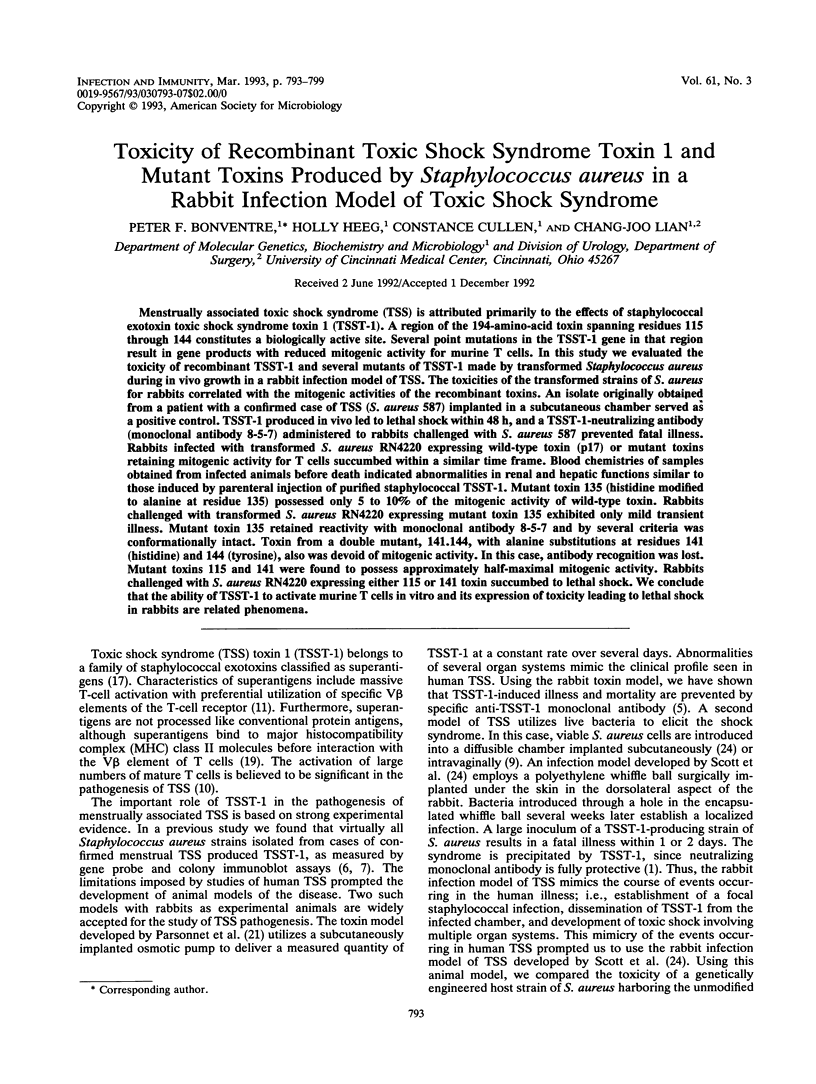
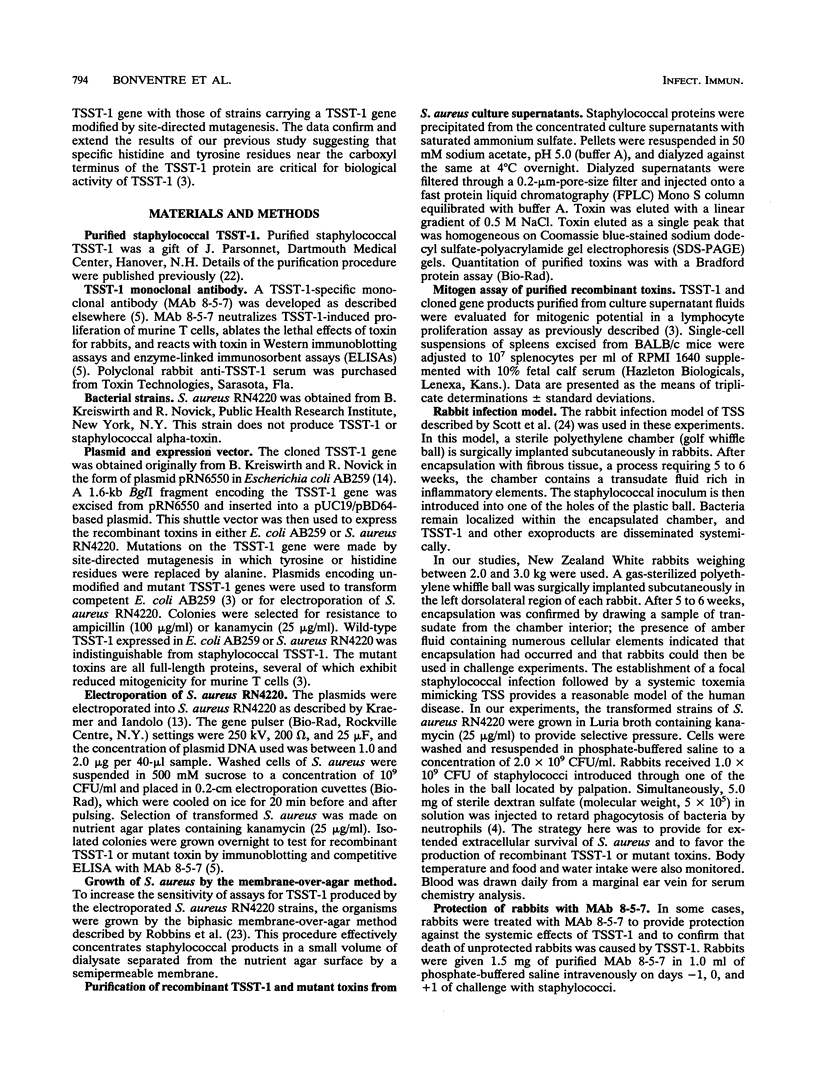
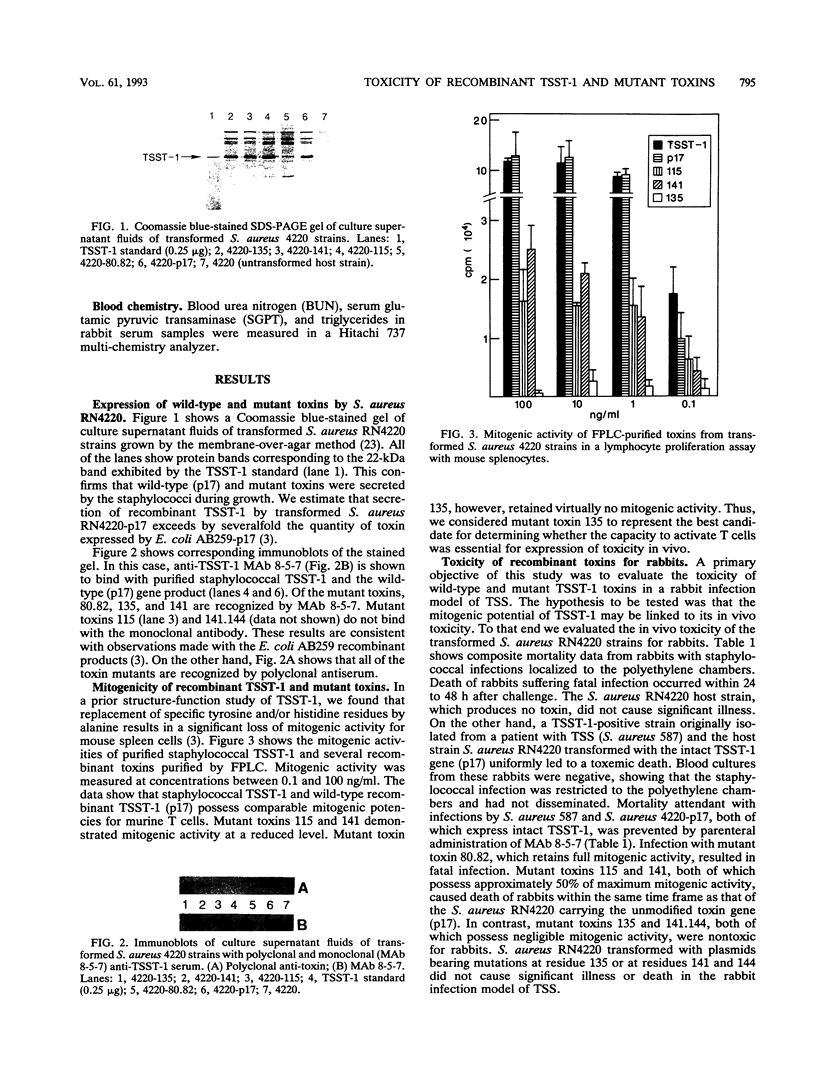
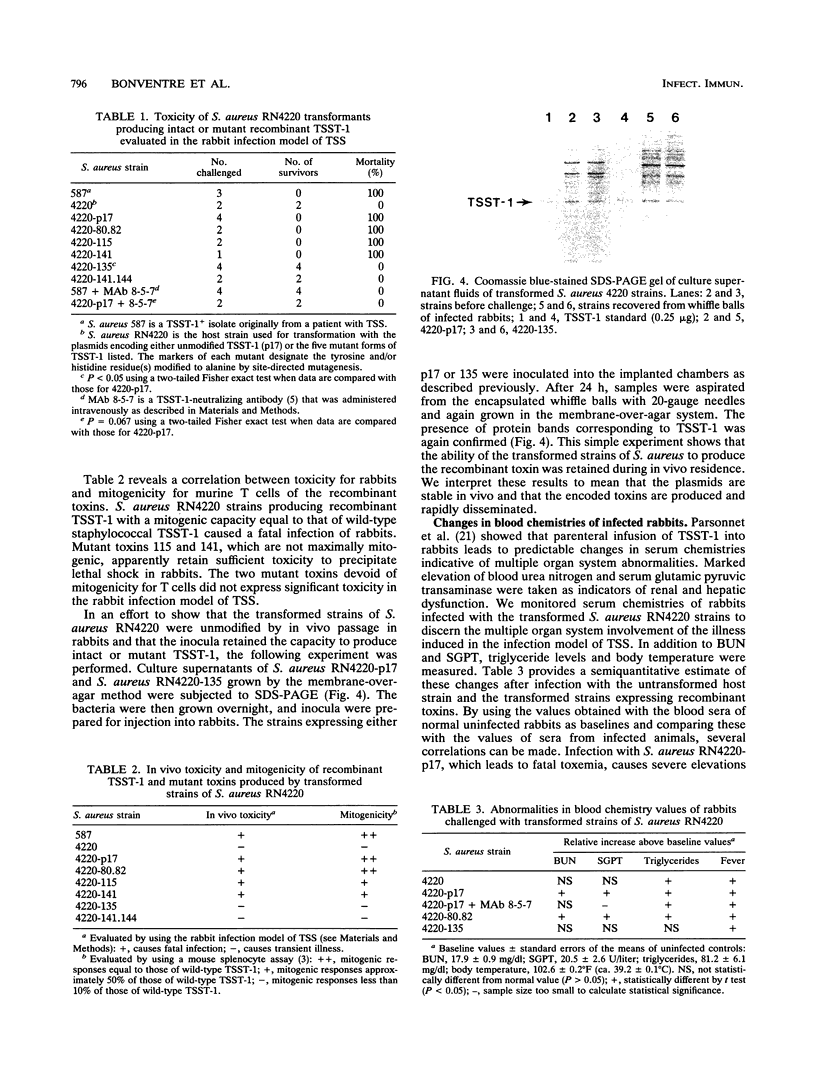
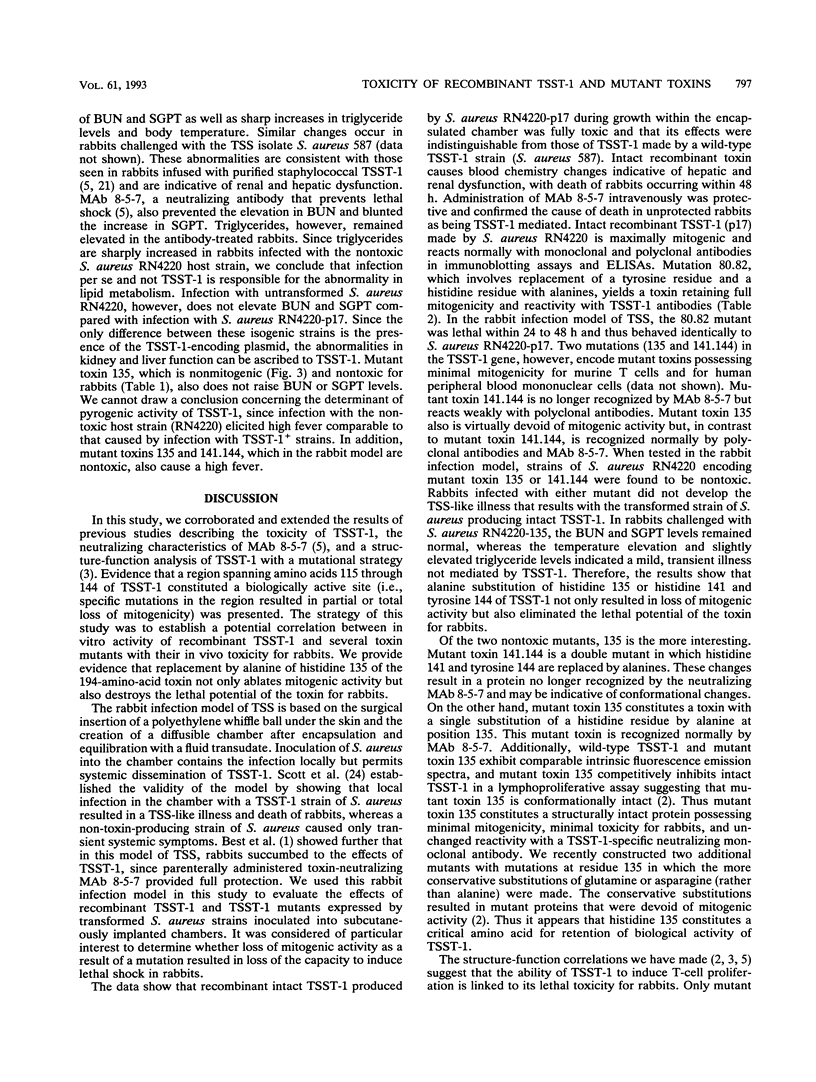
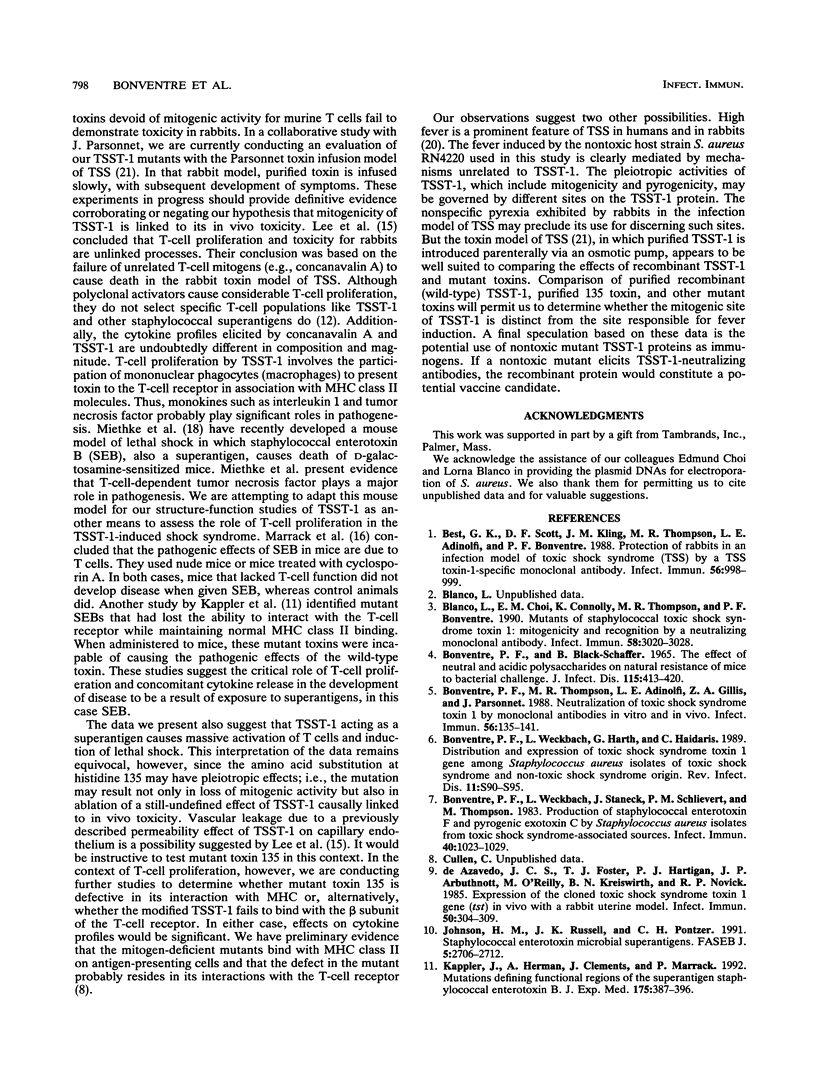
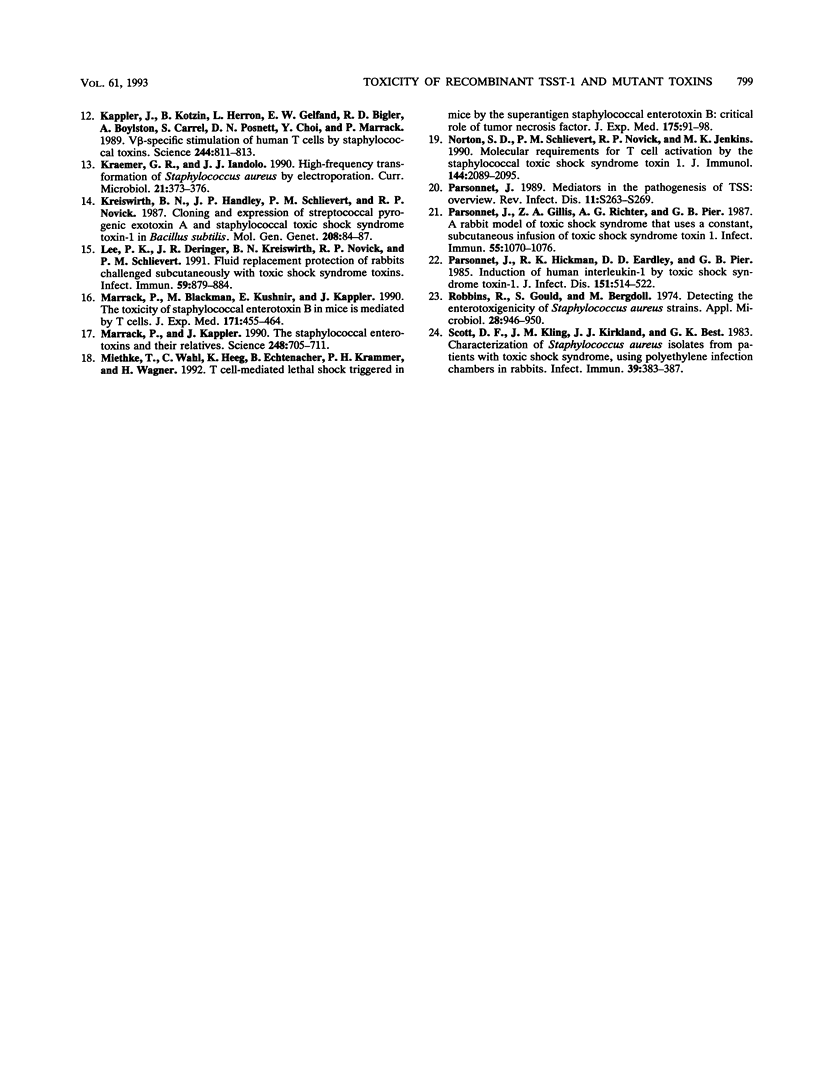
Images in this article
Selected References
These references are in PubMed. This may not be the complete list of references from this article.
- Best G. K., Scott D. F., Kling J. M., Thompson M. R., Adinolfi L. E., Bonventre P. F. Protection of rabbits in an infection model of toxic shock syndrome (TSS) by a TSS toxin-1-specific monoclonal antibody. Infect Immun. 1988 Apr;56(4):998–999. doi: 10.1128/iai.56.4.998-999.1988. [DOI] [PMC free article] [PubMed] [Google Scholar]
- Blanco L., Choi E. M., Connolly K., Thompson M. R., Bonventre P. F. Mutants of staphylococcal toxic shock syndrome toxin 1: mitogenicity and recognition by a neutralizing monoclonal antibody. Infect Immun. 1990 Sep;58(9):3020–3028. doi: 10.1128/iai.58.9.3020-3028.1990. [DOI] [PMC free article] [PubMed] [Google Scholar]
- Bonventre P. F., Black-Schaffer B. The effect of neutral and acidic polysaccharides on natural resistance of mice to bacterial challenge. J Infect Dis. 1965 Oct;115(4):413–420. doi: 10.1093/infdis/115.4.413. [DOI] [PubMed] [Google Scholar]
- Bonventre P. F., Thompson M. R., Adinolfi L. E., Gillis Z. A., Parsonnet J. Neutralization of toxic shock syndrome toxin-1 by monoclonal antibodies in vitro and in vivo. Infect Immun. 1988 Jan;56(1):135–141. doi: 10.1128/iai.56.1.135-141.1988. [DOI] [PMC free article] [PubMed] [Google Scholar]
- Bonventre P. F., Weckbach L., Harth G., Haidaris C. Distribution and expression of toxic shock syndrome toxin 1 gene among Staphylococcus aureus isolates of toxic shock syndrome and non-toxic shock syndrome origin. Rev Infect Dis. 1989 Jan-Feb;11 (Suppl 1):S90–S95. doi: 10.1093/clinids/11.supplement_1.s90. [DOI] [PubMed] [Google Scholar]
- Bonventre P. F., Weckbach L., Staneck J., Schlievert P. M., Thompson M. Production of staphylococcal enterotoxin F and pyrogenic exotoxin C by Staphylococcus aureus isolates from toxic shock syndrome-associated sources. Infect Immun. 1983 Jun;40(3):1023–1029. doi: 10.1128/iai.40.3.1023-1029.1983. [DOI] [PMC free article] [PubMed] [Google Scholar]
- Johnson H. M., Russell J. K., Pontzer C. H. Staphylococcal enterotoxin microbial superantigens. FASEB J. 1991 Sep;5(12):2706–2712. doi: 10.1096/fasebj.5.12.1916093. [DOI] [PubMed] [Google Scholar]
- Kappler J. W., Herman A., Clements J., Marrack P. Mutations defining functional regions of the superantigen staphylococcal enterotoxin B. J Exp Med. 1992 Feb 1;175(2):387–396. doi: 10.1084/jem.175.2.387. [DOI] [PMC free article] [PubMed] [Google Scholar]
- Kappler J., Kotzin B., Herron L., Gelfand E. W., Bigler R. D., Boylston A., Carrel S., Posnett D. N., Choi Y., Marrack P. V beta-specific stimulation of human T cells by staphylococcal toxins. Science. 1989 May 19;244(4906):811–813. doi: 10.1126/science.2524876. [DOI] [PubMed] [Google Scholar]
- Kreiswirth B. N., Handley J. P., Schlievert P. M., Novick R. P. Cloning and expression of streptococcal pyrogenic exotoxin A and staphylococcal toxic shock syndrome toxin-1 in Bacillus subtilis. Mol Gen Genet. 1987 Jun;208(1-2):84–87. doi: 10.1007/BF00330426. [DOI] [PubMed] [Google Scholar]
- Lee P. K., Deringer J. R., Kreiswirth B. N., Novick R. P., Schlievert P. M. Fluid replacement protection of rabbits challenged subcutaneous with toxic shock syndrome toxins. Infect Immun. 1991 Mar;59(3):879–884. doi: 10.1128/iai.59.3.879-884.1991. [DOI] [PMC free article] [PubMed] [Google Scholar]
- Marrack P., Blackman M., Kushnir E., Kappler J. The toxicity of staphylococcal enterotoxin B in mice is mediated by T cells. J Exp Med. 1990 Feb 1;171(2):455–464. doi: 10.1084/jem.171.2.455. [DOI] [PMC free article] [PubMed] [Google Scholar]
- Marrack P., Kappler J. The staphylococcal enterotoxins and their relatives. Science. 1990 May 11;248(4956):705–711. doi: 10.1126/science.2185544. [DOI] [PubMed] [Google Scholar]
- Miethke T., Wahl C., Heeg K., Echtenacher B., Krammer P. H., Wagner H. T cell-mediated lethal shock triggered in mice by the superantigen staphylococcal enterotoxin B: critical role of tumor necrosis factor. J Exp Med. 1992 Jan 1;175(1):91–98. doi: 10.1084/jem.175.1.91. [DOI] [PMC free article] [PubMed] [Google Scholar]
- Norton S. D., Schlievert P. M., Novick R. P., Jenkins M. K. Molecular requirements for T cell activation by the staphylococcal toxic shock syndrome toxin-1. J Immunol. 1990 Mar 15;144(6):2089–2095. [PubMed] [Google Scholar]
- Parsonnet J., Gillis Z. A., Richter A. G., Pier G. B. A rabbit model of toxic shock syndrome that uses a constant, subcutaneous infusion of toxic shock syndrome toxin 1. Infect Immun. 1987 May;55(5):1070–1076. doi: 10.1128/iai.55.5.1070-1076.1987. [DOI] [PMC free article] [PubMed] [Google Scholar]
- Parsonnet J., Hickman R. K., Eardley D. D., Pier G. B. Induction of human interleukin-1 by toxic-shock-syndrome toxin-1. J Infect Dis. 1985 Mar;151(3):514–522. doi: 10.1093/infdis/151.3.514. [DOI] [PubMed] [Google Scholar]
- Parsonnet J. Mediators in the pathogenesis of toxic shock syndrome: overview. Rev Infect Dis. 1989 Jan-Feb;11 (Suppl 1):S263–S269. doi: 10.1093/clinids/11.supplement_1.s263. [DOI] [PubMed] [Google Scholar]
- Robbins R., Gould S., Bergdoll M. Detecting the enterotoxigenicity of Staphylococcus aureus strains. Appl Microbiol. 1974 Dec;28(6):946–950. doi: 10.1128/am.28.6.946-950.1974. [DOI] [PMC free article] [PubMed] [Google Scholar]
- Scott D. F., Kling J. M., Kirkland J. J., Best G. K. Characterization of Staphylococcus aureus isolates from patients with toxic shock syndrome, using polyethylene infection chambers in rabbits. Infect Immun. 1983 Jan;39(1):383–387. doi: 10.1128/iai.39.1.383-387.1983. [DOI] [PMC free article] [PubMed] [Google Scholar]
- de Azavedo J. C., Foster T. J., Hartigan P. J., Arbuthnott J. P., O'Reilly M., Kreiswirth B. N., Novick R. P. Expression of the cloned toxic shock syndrome toxin 1 gene (tst) in vivo with a rabbit uterine model. Infect Immun. 1985 Oct;50(1):304–309. doi: 10.1128/iai.50.1.304-309.1985. [DOI] [PMC free article] [PubMed] [Google Scholar]





